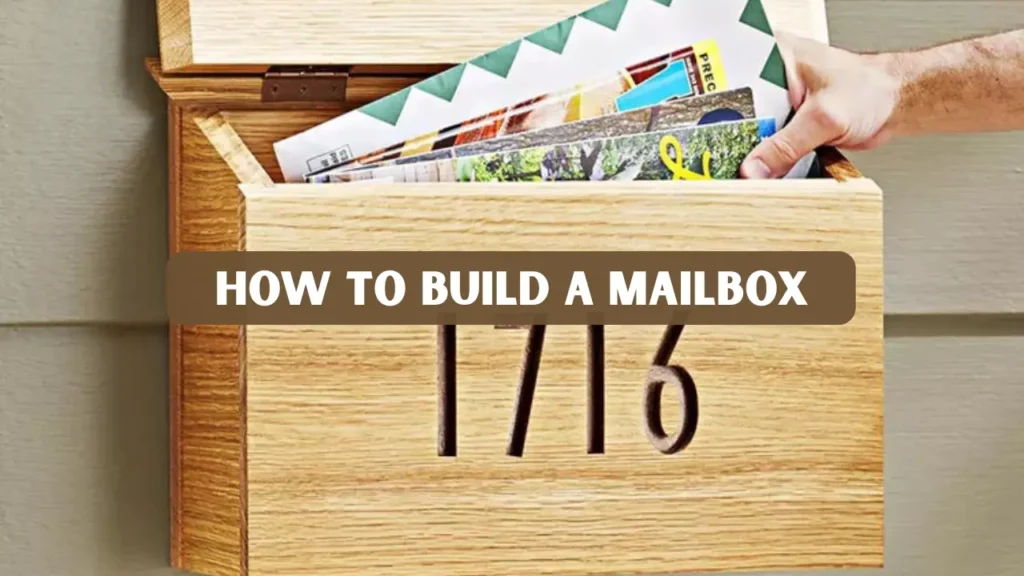When you build a mailbox, you create more than a simple holder for mail. You design a small structure that reflects your craftsmanship and creativity. Whether you prefer a rustic wooden mailbox or a modern design with turned accents, every choice you make adds character. The process allows you to combine skill and style in a project that enhances your home’s exterior.
This guide will walk you through every stage with clear steps and practical advice. By the end, you’ll have a mailbox that is both durable and visually appealing. It will not only serve its purpose but also become a statement of your creativity. A well-crafted mailbox brings charm and a personal touch to any home.
Key Takeaways
- Building a mailbox is a rewarding woodworking project that improves both design and lathe skills.
- This step-by-step guide explains materials, process, and finishing techniques clearly.
- You will learn how to build a mailbox that is functional, decorative, and weather-resistant.
- Real case studies show how everyday woodworkers achieved long-lasting results.
Why Build a Wooden Mailbox
There are many reasons to build a mailbox instead of buying one from a store. It allows you to customize the design, shape, and finish according to your home’s exterior. You can select your preferred wood type, paint color, or carving pattern to create something truly one of a kind.
Building your own mailbox also helps you save money while improving valuable woodworking skills such as measuring, cutting, sanding, and assembling. These techniques can later be applied to more advanced projects.
Finally, a handmade mailbox adds personal value to your property. Every visitor or mail carrier who sees your work appreciates the time and effort behind it. With basic tools, patience, and creativity, anyone can build a wooden mailbox that stands out in durability and beauty.
Choosing the Right Wood
Wood selection plays a major role in durability. Cedar and redwood resist moisture and insects, making them ideal for outdoor use. Pine is easier to shape and more affordable but requires proper sealing to prevent rot. If you want to add turned decorative parts such as finials or posts, choose hardwood sections that can handle lathe work smoothly.
Select straight boards free from cracks or knots. Before cutting, let the wood acclimate to your workshop’s humidity for a few days to avoid warping later.
Designing Your Mailbox
Plan your design on paper before cutting any wood. A classic mailbox typically includes a rectangular body, a sloped roof to shed water, a front door for mail retrieval, and a flag to signal outgoing mail.
Use your creativity to personalize the shape. You can carve decorative grooves, add lathe-turned side knobs, or apply color patterns that match your house exterior.
Materials and Tools
Materials
- Exterior-grade wood (cedar, redwood, or pressure-treated pine)
- Galvanized or stainless-steel screws
- Weather-resistant glue
- Hinges, latch, and flag (optional)
- Primer, outdoor paint, or varnish
- Wood filler and sandpaper
Tools
- Table saw or circular saw
- Drill and bits
- Measuring tape and square
- Lathe with chisels (for turned details)
- Clamps
- Orbital sander
- Safety goggles and ear protection
Choose materials rated for outdoor use to ensure your finished mailbox resists rot, moisture, and fading over time.
Step-by-Step Guide
Step 1: Measure and Cut the Wood
Start by marking your measurements accurately using a tape measure and pencil. A standard mailbox size is about 19 inches long, 8 inches wide, and 10 inches tall, but you can adjust it according to your design. Cut all the panels two sides, top, bottom, front, and back—using your saw.
Make sure all cuts are clean and square. Label each piece to keep track of its position.
Step 2: Assemble the Main Box
Apply wood glue along the edges of the bottom panel, then attach the side panels using clamps to hold them in place. Drill pilot holes to prevent splitting, then secure the panels with screws. Attach the back panel in the same way.
Once the main box structure is complete, allow the glue to dry fully before proceeding to the next step.
Step 3: Create the Roof
Cut the roof pieces so that one edge overlaps the other to form a weatherproof slope. This prevents rainwater from entering the box. Attach the roof panels to the top of the structure with screws and glue.
Sand all the edges smooth to eliminate rough spots.
Step 4: Install the Front Door
Cut a front panel slightly smaller than the opening. Attach it with hinges at the bottom or side, depending on your preferred door style. For easy handling, screw in a small wooden knob or metal handle.
Ensure that the door opens and closes freely. A magnetic latch or small clasp helps keep it securely shut.
Step 5: Add the Mail Flag
Cut a small rectangular piece of wood or metal for the flag. Attach it to one side using a small screw as a pivot, allowing it to move up and down. The flag is optional but adds a classic touch.
Step 6: Sand and Finish
Start with coarse sandpaper (80 grit) to remove rough spots, then move to finer grits (120 and 220) for a smooth surface. Wipe off dust before applying a protective finish.
Use an outdoor-grade sealant, stain, or paint to protect the mailbox from moisture and UV rays. Apply at least two coats for maximum durability.
Step 7: Mount the Mailbox
You can mount your finished mailbox on a post, wall, or decorative stand. If using a wooden post, seal the base with weatherproof paint to prevent ground moisture damage. Make sure it is securely installed and stands at the height recommended by your local postal service.
Step 8: Final Assembly
Once everything is dry, mount the box on the post with weatherproof screws. Check hinge alignment and flag movement. Tighten all connections and wipe away any residue.
Design Enhancements and Personalization
After learning how to build a mailbox, try adding creative touches to make your design unique.
Ideas for personalization:
- Paint your house number in a bold font to make your mailbox easy to identify and visually appealing.
- Add carved letters or small turned trims to give it a handcrafted and unique touch.
- Create a matching wooden newspaper holder to complete the design and add functionality.
- Use a two-tone stain for a polished appearance that highlights the grain and adds depth to the wood.
- Add a decorative roof curve for extra style while helping rainwater run off smoothly.
Small details turn a basic mailbox into a centerpiece for your home’s entrance.
Case Study: Real DIY Success Stories
- James, a 42-year-old woodworker from Oregon, decided to build a mailbox from cedar with lathe-turned accents; it’s been standing strong for over two years with only minor maintenance.
- Similarly, Priya from North Carolina designed a rustic mailbox using reclaimed pine and a hand-turned post toppe, her project not only enhanced her home’s entrance but also won second place at her local woodworking fair.
Cost and Time Estimate
- Materials: $80–$150
- Hardware and finishing: $30–$50
- Estimated total cost: $110–$200
- Time required: 8–12 hours over one weekend
This project offers great value compared to store-bought metal mailboxes.
Safety Guidelines
Safety should always come first.
- Wear protective eyewear and hearing protection to stay safe from flying debris and loud tool noise.
- Avoid loose clothing around the lathe to prevent it from catching in moving parts.
- Clamp all pieces securely before drilling or cutting to maintain accuracy and safety.
- Keep children and pets away from the workspace to reduce the risk of accidents.
- Clean sawdust regularly to prevent slips and minimize the chance of sparks or fire.
Following safety measures ensures a comfortable, injury-free experience.
Maintenance Checklist
To keep your handmade mailbox in top condition:
- Refinish surfaces every two years by sanding lightly and applying a new coat to protect against moisture and fading.
- Inspect hinges quarterly and apply a drop of oil to prevent rust while ensuring smooth movement.
- Tighten screws after harsh weather to keep all hardware stable and secure.
- Remove dirt and debris promptly by wiping the surface with a soft cloth to maintain appearance and durability.
- Check post stability once a year and reinforce the base if it shows any sign of loosening.
Consistent maintenance will help your mailbox last for many years.
Troubleshooting Common Issues
- Uneven lid: Reposition hinges or plane the edge slightly. Check alignment after adjustment to ensure the lid closes smoothly without gaps.
- Loose post: Add additional concrete or a stabilizing brace. Make sure the base is level and allow the concrete to cure fully before remounting the box.
- Cracking wood: Seal end grains and reapply varnish. Use exterior-grade sealant to protect against moisture and sunlight for longer durability.
- Rusty hardware: Replace with stainless or galvanized options. Regularly inspect screws and hinges to prevent corrosion and maintain a polished look.
Quick fixes prevent long-term damage and maintain structural integrity.
Conclusion
When you build a mailbox, you combine function, design, and craftsmanship into one rewarding project. From cutting panels to turning decorative posts, every step brings satisfaction and skill growth.
The two real-life case studies show how everyday woodworkers can create long-lasting, beautiful results with dedication and care. Whether your goal is to practice woodworking, try your lathe, or upgrade your home exterior, this guide helps you achieve a durable, personalized masterpiece.
Your handmade mailbox will serve as both a practical solution and a symbol of your craftsmanship for years to come.
FAQs
1. How long does it take to build a wooden mailbox?
Most people complete it in a weekend, including drying time.
2. What is the best wood for outdoor mailboxes?
Cedar and redwood resist moisture, rot, and insect damage.
3. Can I use a lathe as a beginner?
Yes. Start with basic shapes like smooth posts or finials before moving to complex designs.
4. How do I weatherproof my mailbox?
Apply two coats of marine-grade varnish or exterior paint.




